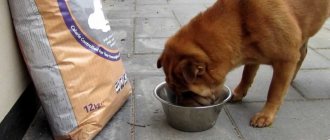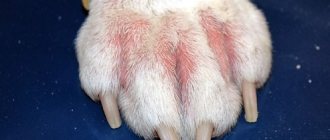Quite often, parasites can live in the body for a long time and not manifest themselves in any way. Sometimes symptoms similar to other diseases may appear, and therefore a completely different disease is treated.
Such situations delay the detection of the disease, which has a detrimental effect on the body of the dog or puppy. Therefore, the animal should be periodically shown to a veterinarian and dewormed regularly.
What to do in such a situation? To get started, we recommend reading this article. This article describes in detail methods of controlling parasites. We also recommend that you consult a specialist. Read the article >>>
In some cases, you can recognize on your own that your pet is infected with worms. Typical symptoms of a puppy or dog having worms include :
- Deviations in the functioning of the gastrointestinal tract. This is expressed by indigestion, increased or lack of appetite, constipation or diarrhea, vomiting, and unnatural food cravings. The pet may begin to eat a lot, but at the same time its body weight decreases.
- Changing the behavior of a dog that becomes sedentary and lethargic.
- The animal's fur becomes disheveled, hard and dull. Dandruff, eczema, and dermatoses may appear.
- Your pet's stool contains mucus, blood, parasites or their larvae.
- The belly of dogs, and especially puppies, swells and becomes hard. Against this background, protruding ribs are visible.
- The pet tries to “ride” on the back of the body because it has severe itching of the anus.
- Difficulty swallowing and hiccups after eating.
- Whiteness of mucous membranes and general anemia.
- Lack of growth and development in puppies.
If the dog is not treated, it will soon begin to vomit worms , and intestinal obstruction may occur, quite often leading to the death of the animal. That is why, if your pet experiences one of the above-described signs, you should immediately contact a veterinarian.
Take a test for worms
Features of worms in dogs
First of all, it is worth noting that in the body of even the most well-groomed and clean pet there is a huge number of a wide variety of parasites. Most of them do not pose a serious danger, but you still need to very carefully monitor the health of your pet.
Every time after a walk or during it, your four-legged pet will certainly lick its paws. When outside, he sniffs grass and feces of other animals with pleasure and is not averse to eating what he finds on the ground.
In this case, the animal may well swallow worm eggs, which, once in the intestines, begin their parasitic activity.
Therefore, it is not surprising that experts discover a huge number of varieties of parasites in animals. Since a person can become infected with worms from a dog, you need to know what problem you might encounter.
Parasites of this type are divided into two groups: round and flat. Worms of the first category, in turn, are usually divided into several subspecies.
Speaking about whether a person can become infected with worms from a dog, it is worth considering this particular variety first. Nematodes are white worms up to 15 cm long. They can be easily seen with the naked eye by looking closely at the animal’s feces. These parasites resemble coiled light springs.
The main feature of nematodes is their fertility. In 24 hours, parasites can lay up to 200,000 eggs. Such dog worms are dangerous for humans, as they can cause toxocariasis.
The main danger is that helminths penetrate the female’s womb. Because of this, newborn puppies may already be infected with a dangerous parasite.
How to give deworming medication to a dog
Most often, deworming medicine for dogs is given with food, but if they refuse such food, you can dilute the tablet with water and pour it into the animal’s mouth with a syringe without a needle. In any case, you can learn how to give deworming tablets to a dog from the instructions.
After taking anthelmintic drugs for dogs, intoxication may occur, since all these drugs are toxic. The pet may be poisoned, be weak and lethargic, and may develop diarrhea. In this situation, it is necessary to immediately vomit and give a dose of absorbent. Moreover, dead helminths sometimes curl up into a ball and clog the intestines. If you suspect that this is what happened or your pet feels very unwell, you should immediately consult a doctor.
Types of parasites in dogs
There are three groups of helminths in puppies and adult dogs. These include:
- cestodes (tapeworms);
- trematodes (flukes);
- nematodes (roundworms).
All of them have varying degrees of danger and location, but have the same negative effect on the animal’s body.
Roundworms
- Toxocara canis are worms with a body length of up to 150 mm, whitish in color, with strongly pointed ends. Live worms found in feces are coiled or coiled, like threads. Infection can occur in utero, through breast milk or through contact with contaminated surfaces. The eggs remain fully active throughout the year;
- Toxacaris leonna are worms that live in the intestines, but the larval form develops only in the stomach, after which it does not migrate, due to this it is capable of causing little harm to the pet;
- Ancylostoma caninum are small, yellowish nematodes, the length of which does not exceed 20 mm, and the head end has a pronounced rounding. The mouthparts of the worm are huge compared to its overall size and are represented by several rows of very sharp hook-shaped teeth;
- Uncinaria stenocephala are relatively small parasites, the length of which does not exceed 20 mm. The species is distinguished by its extreme fertility and gluttony, as well as its almost ubiquitous distribution. The oral apparatus is represented by a pair of sharp plates that easily injure the intestines of a four-legged pet;
- Dirofilaria are whitish nematodes of a typical appearance, with a very characteristic narrowing at the end. The female parasitic worm is larger in size, reaching a length of 150 mm. The larval stage is tiny, with a rounded anterior end. An animal becomes infected through a mosquito bite.
Flatworms
- Dipylidium caninum is a typical representative of tapeworms, the body of which is represented by individual segments. Inside a large animal, the length of such a worm can be 150 cm. Mature segments emerging with feces dry out quite quickly, after which they rupture, and the eggs enter the dog’s stomach with blood-sucking insects;
- Eschinosoccus is a small parasitic worm, and the length of an adult can rarely exceed 5.0 mm. A feature of the oral cutting apparatus is the presence of several dozen very sharp hooks, which significantly damage the dog’s intestinal tract and often cause the death of not only puppies, but also the youngest individuals;
Echinococcus
- Diphyllobothrium latum is a huge tapeworm, up to ten meters long, consisting of several hundred relatively large “segments”. A dog becomes infected by eating raw fish that has not undergone heat treatment;
- Oristhorchida are small-sized flukes, distinguished by the presence of a pair of suckers of the oral and peritoneal type. The main localization of the parasitic worm is noted inside the dog's gallbladder and bile ducts, as well as in the tissues of the liver or pancreas.
Pets infected with extremely dangerous flukes, which can in a short time not only disrupt the functionality of internal organs, but also completely destroy their healthy tissue, suffer especially hard.
Find medications for parasites
This service is a small help in finding cures for parasites. To start using it, select the type of parasite. If you don’t know what kind of parasite you are infected with, this parasite identification tool will help you by symptoms.
Ways of infection with worms
In the vast majority of cases, a dog becomes infected with worms by ingesting their eggs. But there is another way of infection - transmissible, through the bites of blood-sucking insects.
In addition, the parasite can enter through lesions on the animal's skin. Newborn puppies easily become infected from their mother, who is a carrier of helminthic infestation.
Helminth eggs can enter the pet’s body if:
- the owner does not pay enough attention to the sanitary and hygienic side of the life of his four-legged friend;
- the dog is not given preventive deworming;
- the pet eats raw meat and fish;
- the dog often walks unaccompanied (dubious “acquaintances” are possible, drinking from puddles, eating various leftovers, and so on);
- There are other animals living in the apartment that have worms.
Under other favorable conditions, a pet can become infected even at home by sniffing the shoes of an owner who comes in from the street.
Note: no dog is immune from worms, but the risk group includes animals with weakened immune systems, puppies, hunting and yard dogs.
Why are helminths dangerous for dogs?
If left untreated, worms in dogs can lead to serious consequences over time, including:
- weakened immunity and retarded growth and development due to insufficient supply of nutrients to the animal’s body;
- mental exhaustion of the dog due to constant itching, pain, discomfort;
- the addition of infection against the background of a decrease in protective forces, the development of numerous diseases;
- serious intoxication of the pet’s body with toxic metabolic products of parasites, the development of allergic reactions.
Helminths lead to diseases of the liver, brain, heart, lungs and other organs. Ignoring the symptoms of worms in a dog is fraught with the development of jaundice, heart attack, epilepsy, intestinal obstruction, cerebral hemorrhage, loss of vision and other consequences, including death.
Important: according to statistics, more than 60% of domestic dogs are infested with helminths. At the same time, infected pets look clinically healthy, so owners do not always suspect that their beloved animal is sick.
Deworming drugs
If the worms have already entered the animal’s body and are actively spreading in the intestines, then action must be taken immediately. The veterinarian will help you choose a remedy for worms in dogs. The following positions deserve special attention:
- Drontal. Available in the form of tablets and suspensions. The first are of two types - for puppies and small breed dogs (per 10 kg of weight), for animals weighing more than 35 kg. The tablets are produced in the form of a stone.
- Prazitel. Available form: tablets and suspension. An anthelmintic suitable for fighting worms. The dose is calculated based on the weight of the animal.
- Helminthal. The drug rarely causes adverse reactions. Available form: suspension or droplets on the withers (from parasites living on the fur). The medicine is not prescribed to collies, shelties and bobtails; these breeds do not tolerate it well.
- Droncite. Available form: tablets, solution for injection. The drug is safe for pregnant bitches and non-toxic for puppies.
- Milbemax. The tablets are suitable for treating gastrointestinal parasites and come in two types – for puppies and small breeds and large dogs. Causes side effects in collies and shelties.
Causes of helminthiasis
Initially, it is necessary to determine the correct age of the pet. Dogs of most small breeds remain puppies until they are six months old, and large breeds until they are one year old.
It is this parameter that is often decisive, because any helminths affect the health and general condition of a five-year-old dog and a three-month-old puppy very differently.
In addition, the oldest animals are able to more calmly tolerate treatment or so-called deworming, while in the smallest pets this procedure sometimes ends very tragically, even in death.
For this reason, you should remember the dangers of such internal parasites, as well as promptly diagnose their presence in the dog’s body and competently, as effectively as possible, get rid of helminthiasis.
Important! The main routes of infection for a dog are represented by living carriers of the disease in the form of contact with sick animals, ticks or fleas, as well as the pet visiting places where there is a high risk of contact with objects heavily contaminated with helminths or their eggs.
As numerous studies show, only periodic and competently carried out deworming of a pet can be the key to a dog’s well-being and full development, regardless of its main breed qualities or age characteristics.
Routes and methods of infection
Modern veterinary medicine and the pet industry have reached unprecedented heights, but neither can convince animal owners to take prevention seriously. We are talking about vaccinations, prevention of helminths and blood-sucking parasites. The vast majority of owners give their dogs fleas because they are visible. Worms are often forgotten, and this happens only because the owner overlooks obvious signs of infestation.
Note! Infection with worms can be judged by the appearance of the dog: dull fur, poor condition of the skin and claws.
It is impossible to protect yourself 100% from worms. Accept it as a fact that the dog has worms, and you have them too. There is no need to panic or try to deceive nature; the goal of prevention is to prevent the proliferation of parasites. The life cycle of most worms can be divided into periods of 3–5 months. That is, the parasites live quietly for 3 months, and after that, peak infestation occurs. It is for this reason that I recommend treating dogs once every 3 months. Some types of worms reproduce constantly, without peaks and valleys; there are worms that cannot be overcome with conventional drugs - you need to know these nuances.
Helminths are a large family divided into species. Nature arranges it in such a way that the most common worms are easy to eliminate, but rare ones, which are difficult to infect, cannot always be cured using traditional methods. Absolutely any environment is infested with parasite eggs, but this does not mean that infection will occur immediately after contact. Almost all types of worms, except the most common ones, must go through certain stages of maturation in order to parasitize dogs or people. Particularly dangerous worms that develop using multiple hosts.
Note! The eggs of some parasites can be airborne.
Infection with worms does not pose a threat until the parasites have multiplied to impressive numbers. The more worms, the more painful the dog's condition. This happens because helminths feed on blood, lymph, tissues and nutrients in the intestines. Even when infected with primitive roundworms, the animal quickly develops vitamin deficiency and experiences weight loss.
Another negative factor in infection with worms is intoxication. During their life, worms excrete waste products, and when the invasion reaches a critical level, some of the parasites die. The waste of worms and their decomposing remains are a constant source of toxins that “hit” the liver, kidneys and health of the pet in general.
Note! Long-term infestation without intervention from the owner can lead to intestinal blockage.
An adult dog can fight parasites for quite a long time, but if worms actively multiply in the body of a young dog, everything can end tragically. A puppy's intestinal walls are thinner and not as strong as those of an adult dog. When affected by worms that multiply quickly, the intestines can simply rupture. In addition, young animals are difficult to tolerate intoxication; they refuse to eat, are stunted in growth and quickly weaken.
Are they visible in stool?
Helminths live in or pass through the intestines, so detecting their presence in a dog's feces is usually not difficult.
If there are a large number of worms in the dog’s body, the feces may contain the worms themselves. But most often in the feces there are eggs or larvae of worms, similar to grains or crumbs, which are not always amenable to examination.
You can also suspect helminthiasis in a dog by examining the hair around the dog's anus. There you can find worm eggs, which end up outside after adult tapeworms have laid eggs in the intestinal lumen.
As with feces, worms can be seen in your dog's vomit. This occurs when there are a large number of parasites in the animal’s body. Vomit may also contain eggs and larvae, but it is not always possible to see them due to their small size.
In the photo below you can see what worms, their larvae and eggs look like in dog feces.
Treatment of worms in puppies and dogs
Anthelmintic drugs are prescribed to animals only after a diagnosis is made, which is determined in the laboratory. To do this, the feces are examined for worm eggs . In some cases, parasites come out along with feces and then their type can be determined independently.
It is better not to give anthelmintic drugs intended for the treatment of people to a dog or puppy. They should be purchased on the recommendation of doctors in pet stores.
Puppies are most often infected with the nematode Toxocara caris, for which experts recommend using the drug Drontal Genior. This sweet suspension is injected into the puppy's mouth using a syringe.
For puppies under the age of one month, drugs are purchased in the form of a suspension , and dogs older than one month are given anti-parasite tablets.
Adult pets are treated with broad-spectrum drugs. The doctor may prescribe Azinox plus, Drontal plus and others. Since long-term use of the same drug can lead to addiction, it is recommended to alternate them.
Anti-worm tablets include the drug Milbemax, which you can prescribe to your dog yourself. This remedy can be used against all types of helminths, especially before your pet’s annual vaccination. Since animals infected with worms have a weakened immune system, they must be treated before receiving the vaccine.
Milbemax is a universal drug, since it contains a chemical substance that affects not only cestodes and nematodes, but also their larvae.
Milbemax is given to the dog in the morning before meals for 7-14 days . The course of treatment depends on the biology of the parasite. It is recommended that you inspect your pet's stool to see live or dead worms and determine the effectiveness of treatment. Most often, deworming is repeated according to the instructions.
How to carry out deworming?
Anthelmintic drugs must be given to the dog in the morning, placing the tablet in minced meat or wrapped in sausage, meat or some kind of treat. If your pet refuses to take the medicine, you need to squeeze his jaw with your hands, lift it up and place the tablet deep on the root of the tongue. For puppies, they buy suspensions or crush the tablets to a powder, dilute them with water and pour them into their mouths using a syringe.
In some cases, a dog may feel unwell after taking the medicine . You need to immediately give her enterosgel or another absorbent and consult a veterinarian.
Almost all modern drugs act in such a way that the worms are broken down partially or completely. Therefore, living or dead parasites may not be visible in animal feces. Be sure to monitor your pet during deworming. Sometimes he will need help to cleanse himself, for which a laxative is given or an enema is given.
Anti-worm medications for puppies
If helminths are the cause of vomiting, growth retardation, loss of appetite and other symptoms, the specialist prescribes anthelmintic drugs that have a wide spectrum of action. This is based on the fact that there are many cestodiases and nematodes, and it is difficult to establish for certain which type of worms affected the puppy’s body.
The drugs are prescribed by the doctor taking into account age, the degree of neglect of the pathological process and other characteristics. The dosage must be individual and it is important to follow it when treating at home.
To make a diagnosis in a clinical setting, a number of necessary studies are carried out. They include a general blood test, and necessarily a general analysis of urine and stool. Only on the basis of the data obtained, the veterinarian prescribes anthelmintic drugs, since they have a sufficient degree of toxicity that is detrimental to parasites.
The most commonly prescribed anthelmintic drugs are:
- Drontal Junior is an anti-worm tablet that has a pronounced destructive effect on nematodes. The drug can be used from the age of two weeks.
- Prazitel is a universal anthelmintic drug that affects all types of worms that parasitize the body of dogs. Effective against round, flat and tape helminths. The drug is prescribed for mixed types of infection. Prazitel can be used to treat puppies from two weeks of age.
- Anti-worm suspension for puppies Prazicide - has a wide spectrum of action on round and tapeworms. It is prescribed to puppies when they reach three weeks of age.
Grown-up puppies can use such products as Helmintal in the form of a suspension (effective in treating animals with tapeworms and nematodes), Droncit (praziquantel), available in several forms (suspension and tablets). Affects intestinal helminths in both adult dogs and puppies. A good remedy for worms is Milbemax. Effective against helminthiases caused by tapeworms and roundworms. Can be used for puppies from two weeks of age.
Before giving medicine to a puppy, you must carefully study the instructions and properly prepare for anthelmintic treatment. It is important to follow the dosage prescribed by your doctor. Otherwise, the toxic substance can have a detrimental effect on the puppy’s weakened body and cause the development of poisoning. If you deliberately reduce the dosage prescribed by the veterinarian, you will not be able to get rid of parasites.
Routine deworming is marked by the first vaccination. Antiparasitic treatment is important before serum administration. According to the vaccination calendar developed by experts, the first vaccine is administered at the age of 2 months. Before this time, at least 2 weeks in advance, it is necessary to treat your pet for worms. This will allow the injected serum to work as it should and create a lasting immune response against dangerous infections.
Before giving anthelmintics, it is important to treat the animal against ectoparasites (fleas, ticks or lice). Otherwise, deworming treatment will not have a lasting effect. Companies developing antiparasitic drugs often combine several drugs to prevent re-infestation of the puppy.
Prices for drugs for anthelmintic treatment of dogs
- Agrovet protection Alben S, 6 tablets, from 100 to 110 rubles;
- Milprazone, 2 tablets, from 297 to 315 rubles;
- Api-San Prazicide-suspension Plus, 10 ml, from 145 to 150 rubles;
- Novartis Milbemax, 2 tablets, from 530 to 540 rubles;
- Drontal (Bayer) plus, 1 tablet, RUB 332;
- Api-San Dirofen suspension – deworming remedy for dogs, 10 ml, 175 RUR;
- Helmintal, 10 ml, from 280 to 300 rubles;
- Cestal plus, 1 tablet, from 100 to 110 rubles;
- Api-San Prazicide-suspension Plus, 10 ml, from 149 to 155 rubles;
- Levamisole – anti-worm injection, 50 ml, from 50 to 75 rubles;
- Euracon Pharma Kanikquantel plus XL, 12 tablets, from 1750 to 1900 rubles.
- Advocate (Advocate), 1 pipette, from 350 to 370 UAH;
- Caniquantel Plus, 1 tablet, from 30 to 32 UAH;
- Procox – suspension, 7.5 ml, from 190 to 195 UAH;
- Profender (Profender), 1 tablet, from 45 to 47 UAH;
- Dironet, 6 tablets, from 99 to 105 UAH;
- Prazicide Suspension Plus (Api-San), 10 ml, from 49 to 50 UAH;
- Palladium GOLDEN DEFENCE, 1 pipette, 125 UAH;
- Milbemax, 2 tablets, from 109 to 110 UAH;
- Bioveta Kaniverm – for puppies, 1 tablet, from 28 to 29 UAH;
- Levamisole – for injection, 10 ml, from 7 to 9 UAH;
- Livisto Aniprazol (Aniprazol), 1 tablet, from 67 to 69 UAH.
Medications
There are many anthelmintics for dogs, depending on the type of infestation. If it is not possible to take tests and visit a specialist, you can choose a broad-spectrum drug.
Alben
You can choose the drug Alben: they give one tablet per 5 kg. weight with the first morning feeding, or a suspension is prepared from it in a small amount of water. No fasting is required before taking it, and there is no need to give a laxative afterwards. Alben deworming tablets are effective at all stages of worm development.
Drontal
You can also choose Drontal deworming tablets for dogs. They are flavored and shaped like a bone, and are given in the morning during feeding at the rate of 1 tablet per 10 kg. weight. They help well in the prevention of helminthiasis. Roundworms are killed, after which they are easily removed from the intestines. The good thing about the drug is that when taken, the risk of side effects is minimal; it is recommended by veterinarians most often. For puppies it is available in the form of a suspension, Drontal Junior.
Kanikquantel Plus
Kanikquantel Plus is effective against nematodes, trematodes and flat helminths. Can be given to puppies from 3 weeks, contraindicated in females during pregnancy. However, dogs are reluctant to eat the medicine, and in case of an overdose, diarrhea and vomiting may occur. If you follow the instructions, side effects are rare. A nice bonus is value for money.
Milbemax
The drug is highly effective, but also has a number of contraindications: it is not recommended for puppies under 2 weeks of age and animals with impaired functions of internal organs. Available in two dosages: for adult dogs and for puppies and small dogs. When taking the drug, be sure to pay attention to the health of the dog; it is not suitable for sick animals and can cause adverse reactions in them (uneven gait, trembling and weakness).
Advocate
Owners who cannot force their pet to take medication can use Advocate drops on the withers. The packaging should be selected depending on the weight of the animal; it should be applied to healthy areas of the skin. The drug is prohibited for weakened animals and puppies under 7 weeks. After use, a local reaction is possible, but it passes quickly. Caution: the medicine is not effective against flatworms and tapeworms.
Panacur
Broad-spectrum anthelmintic agent. Affects worms at any stage of development. Available in granule form. Before using Panakur, it is necessary to correctly calculate the dosage, which depends on the degree of infection and the weight of the dog. It is advisable to consult a veterinarian. The drug is low-toxic, odorless and tasteless.
Are worms in dogs dangerous for humans?
The most important question that concerns pet owners is whether worms are transmitted from dogs to humans? Parents of young children are especially worried about this. No one wants to overshadow the joy of communicating with an animal by such an unpleasant and even dangerous moment. This question is often asked in the veterinarian's office.
The first thing to remember is that not all types of dog worms are dangerous to humans. Secondly, most parasites are not able to develop in an unnatural habitat. Third, parasites are transmitted from pets to humans through the fecal-oral route, that is, through the mouth.
The eggs of sexually mature female worms are released in dog excrement. They can remain on the animal's fur or objects. Children and adults who do not maintain personal hygiene may accidentally ingest them.
What can a person get sick with?
- Echinococcosis. The disease is caused by the parasite Echinococcus granulosus, which lives in the small intestine of dogs. Children who have too close contact with pets are most susceptible to the disease. The helminth larva cannot develop inside a person; it migrates throughout the body and settles in the liver or lungs. A cyst forms around it and grows over several years. Symptoms of infection appear too late, when the cyst reaches a large size - this is an incessant cough, pain in the chest or abdomen, diarrhea, nausea and vomiting. Severe allergies and anaphylactic shock are signs of a violation of the integrity of the cyst.
- Toxocariasis. The causative agent is the helminth Toxocara canis. The parasite larvae are carried into the bloodstream throughout the body. They can settle in the eyes - ocular toxocariasis. In the lungs, liver and central nervous system - visceral toxocariasis. Complications depend on the form of the disease: loss of vision, pneumonia, cirrhosis of the liver.
- Alveococcosis. The causative agent is the tapeworm Echinococcus multilocularis. A very common disease that affects any internal organs. Patients lose weight and feel general weakness. In advanced cases, cirrhosis of the liver and inflammation of the biliary tract develop. Possible death.
- Coenurosis. The disease is caused by tapeworm larvae. Cysts - tsenura - form around the larvae. The clinic manifests itself in different ways. It all depends on where the cyst is located. In the spinal cord - paralysis of the lower limbs. Brain – migraine, weakness, loss of consciousness and convulsions. In the eyes – decreased and complete loss of vision. Cysts in the brain are a common cause of death.
- Dipylidiasis. The disease is caused by the tapeworm Dipylidium caninum. When the parasite penetrates the intestines, it grows into an adult. Symptoms: diarrhea, itching, rash, abdominal pain. In advanced cases, intestinal obstruction is possible.
All these dangerous diseases can be prevented by strictly observing the rules of personal hygiene and hygiene of pets: clean the dog’s area, wash your hands with soap after each contact with the animal and before eating, close children’s sandboxes with a lid, and do not allow children to play in dog-walking areas.
Take a test for worms
Preventive actions
Puppies should be dewormed starting in the first months of life. The first time the procedure is carried out approximately in the third week after birth, after the same period of time the procedure is certainly repeated.
Prevention of helminthiasis in adult pets should be done once every three months. The anthelmintic drug is given to the dog during meals. If there is such a need, the procedure is repeated after 10 days.
An experienced veterinarian will tell you which medications to use for the treatment of helminthiasis in puppies or adult dogs. He will indicate the correct dosage and select a regimen for taking those medications, the price of which will suit the wallet of the animal owner.
You should not refuse the help of a specialist if you really care about the health of your pet.
Signs in a puppy
To make sure that your puppy has worms, look at his behavior and appearance. Signs of infection are:
- low mobility;
- poor growth;
- matte wool;
- bluish rim of the whites of the eyes;
- increased appetite, but lack of weight gain, vomiting, diarrhea;
- constipation, blood, mucus, worms are visible in the stool;
- bloated stomach, frequent rumbling, enlarged liver.
It is possible to defeat parasites!
Antiparasitic Complex® - Reliable and safe removal of parasites in 21 days!
- The composition includes only natural ingredients;
- Does not cause side effects;
- Absolutely safe;
- Protects the liver, heart, lungs, stomach, skin from parasites;
- Removes waste products of parasites from the body.
- Effectively destroys most types of helminths in 21 days.
There is now a preferential program for free packaging. Read expert opinion.
Interesting to know:
Bibliography
- Centers for Disease Control and Prevention. Brucellosis. Parasites. Link
- Corbel MJ Parasitic diseases // World Health Organization. Link
- Young EJ Best matches for intestinal parasites // Clinical Infectious Diseases. — 1995. Vol. 21. - P. 283-290. Link
- Yushchuk N.D., Vengerov Yu.A. Infectious diseases: textbook. — 2nd edition. - M.: Medicine, 2003. - 544 p.
- Prevalence of parasitic diseases among the population, 2009 / Kokolova L. M., Reshetnikov A. D., Platonov T. A., Verkhovtseva L. A.
- Helminths of domestic carnivores of the Voronezh region, 2011 / Nikulin P. I., Romashov B. V.
An article for patients with a doctor-diagnosed disease. Does not replace a doctor's appointment and cannot be used for self-diagnosis.
The best stories from our readers
Topic: Parasites are to blame for all troubles!
From: Lyudmila S. ()
To: Administration Noparasites.ru
Not long ago my health condition worsened. I began to feel constant fatigue, headaches, laziness and some kind of endless apathy appeared. Problems also appeared with the gastrointestinal tract: bloating, diarrhea, pain and bad breath.
I thought it was because of the hard work and hoped that it would go away on its own. But every day I felt worse. The doctors couldn’t really say anything either. Everything seems to be normal, but I feel like my body is not healthy.
I decided to go to a private clinic. Here I was advised, in addition to general tests, to get tested for parasites. So in one of the tests they found parasites in me. According to doctors, these were worms, which 90% of people have and almost everyone is infected, to a greater or lesser extent.
I was prescribed a course of antiparasitic medications. But it didn’t give me any results. A week later, a friend sent me a link to an article where some parasitologist shared real tips on fighting parasites. This article literally saved my life. I followed all the advice that was there and after a couple of days I felt much better!
Digestion improved, headaches went away and the vital energy that I so lacked appeared. To be sure, I took the tests again and no parasites were found!
Anyone who wants to cleanse their body of parasites, no matter what types of these creatures live in you, read this article, I’m 100% sure it will help you! Go to article>>>
Still have questions? Ask them in our Anonymous group on VK
How to get rid of parasites in a week. The answer is here!
A reliable and effective remedy for combating worms. Removes all parasites in 21 days.
Go to website
Reviews
Read online
Symptoms that 100% indicate parasites! Take the Test.
How to rid your body of life-threatening parasites before it’s too late!
Read more
Website
To get a consultation
The doctor tells how to quickly get rid of parasites for adults and children!
A parasitologist explains what effective methods exist to combat helminths.
More details
Read completely
Comments
Search for cures for parasites
This service is a small help in finding cures for parasites. To start using it, select the type of parasite. If you don’t know what kind of parasite you are infected with, this parasite identification tool will help you by symptoms.
We recommend reading
Toxoplasmosis in dogs: routes of infection, symptoms and treatment
1 week ago 01/29/202102/1/2021ecoliv94
Worm inspector for cats: instructions for use, cost
1 week ago 01/27/202102/02/2021ecoliv94
Products for cats against ticks and worms: list of the best
2 weeks ago 01/25/202102/3/2021ecoliv94
Dirofen against worms for cats and dogs: instructions for use, price, analogues
2 weeks ago 01/25/202102/3/2021ecoliv94
Recommendations for purchasing deworming tablets for dogs and puppies
When purchasing deworming tablets, you must follow the advice of veterinarians:
- all medications are given to the animal only as prescribed by a veterinarian;
- You need to purchase medicinal products from veterinary pharmacies, checking the expiration date;
- it is important to pay attention to contraindications;
- For the effectiveness of the procedures, it is better to change medications periodically so that the body does not get used to them;
- before starting treatment, it is better to get tested for parasites; if the animal does not have many of them, you should not frequently carry out anthelmintic therapy;
- it is important to protect the animal’s body from the harmful effects of anthelmintic drugs, for this the dog is given sorbents, they will help remove toxic substances from the body that can harm the dog’s health;
- It is necessary to ensure that the dog swallows the tablet.











